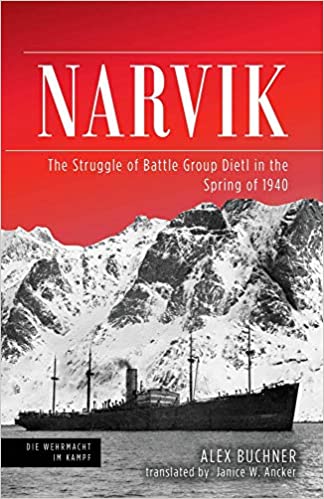Reviewed by Tyler Robinson
Translator Janice W. Ancker has made Alex Buchner’s 1958 treatise on the 1940 conflict over the Norwegian city of Narvik available in English for the first time as part of the “Die Wehrmacht Im Kampf” book series from the Center for Historical Analysis and Conflict Research (CHACR), the British Army’s own think tank. Ancker has previously translated Hitler’s Wehrmacht, 1935—1945 and The Forgotten Front: The Eastern Theater of World War I, 1914 – 1915. She is thus no stranger to the subject matter.
In the Second World War, Alex Buchner rose through the ranks of the Wehrmacht’s mountain troops to become a First Lieutenant in command of a company of men, and in the post-war era he attained the rank of Major in the Bundeswehr’s reserves. This operational expertise made him ideally suited to integrating preexisting personal narratives in order to present the first truly comprehensive overview of this conflict.
Nevertheless, a foreword written by the Head of Historical Analysis at the CHACR, Professor Matthias Strohn, rightly notes that this detached assessment of the German military’s operational effectiveness at Narvik turns a blind eye to the detestable Nazi ideology driving not just the invasion of Norway but also Eduard Dietl himself, whose strategic savvy Buchner celebrates.
Narvik is a relatively short read but it is written in a parsimonious style that offers little hand-holding. As such, a familiarity with the minutiae of military movements, the organization of the Third Reich’s military, and/or the geography of Norway will make the narrative easier to follow. A layman will not require any outside source to make sense of the text, but the many units and locations at play may prove challenging at times for a casual reader.
Included at the beginning of the book are a number of German maps featuring naval and infantry movements alike, though perhaps inclusion of illustrations and English maps embedded within the main text would have ameliorated the barriers to those not already acquainted with the books subject matter as they attempt to visualize Buchner’s blow by blow account of the conflict over Narvik.
The appendices also include orders of battle for the German forces under Dietl as of April 9, May 13, May 27, and 9 June, as well as Allied forces in the vicinity as of April 17, May 10, and June 3. The changing troop levels over the duration of the conflict are also incorporated into the main narrative itself.
The Wehrmacht and Kriegsmarine forces engaged at Narvik were confronted by a desperate shortage of supplies even as they were struggling to preserve access to Swedish iron ore to feed the war machine back in Germany. Norwegian and Allied forces were not so troubled with supply shortages. Their apparent inability to mass and leverage superior firepower in order to break the entrenched German presence in Narvik is attributed primarily to a combination of excessive caution in the face of unpredictable and deadly environmental conditions as well as poor coordination between the many international stakeholders. Communication and coordination likewise represented a constant struggle for the German forces. The movement of materiel across fjords presented a frequent logistical challenge, as did maintaining radio contact between extremely dispersed forces.
Above all the narrative of Narvik conveys the grueling nature of Arctic combat. The German forces in and around the city of Narvik suffered severe losses to cold and starvation. When the summer thaw came, it only served to worsen conditions, as keeping dry became immeasurably more difficult, and troops even drowned in the slush. Furthermore, the troops were often forced to bivouac in rocky mountain climes, rather than the warmer lowlands with wood and soft earth for shelter, given the strategic importance of high ground for keeping the enemy in their sights at range.
Heavy snowfall and fog meant that it was at times impossible to see the enemy at more than a few paces, making close quarter combat and stealth operations a major part of the conflict, but such conditions could disappear as quickly as they appeared. The arctic sunlight also enabled visibility—and consequently, combat—to continue at all hours of the day and night.
Buchner, by way of Ancker, has presented an intensely detailed historical account and counterfactual analysis of the strategic dilemmas faced by German and Allied forces at Narvik. As such this book may be of particular interest to those engaged in wargaming and military simulations as a well as historical enthusiasts more generally.
Tyler Robinson graduated with an MLitt in International Security Studies from the University of St Andrews in 2018. He has also contributed reports on emerging technologies and geopolitical threats for OODA LLC.
Narvik: The Struggle of Battle Group Dietl in the Spring of 1940 (Alex Buchner, Translated by Janice W. Ancker, Casemate Publishers, Havertown, PA and Oxford, UK, 2020)


